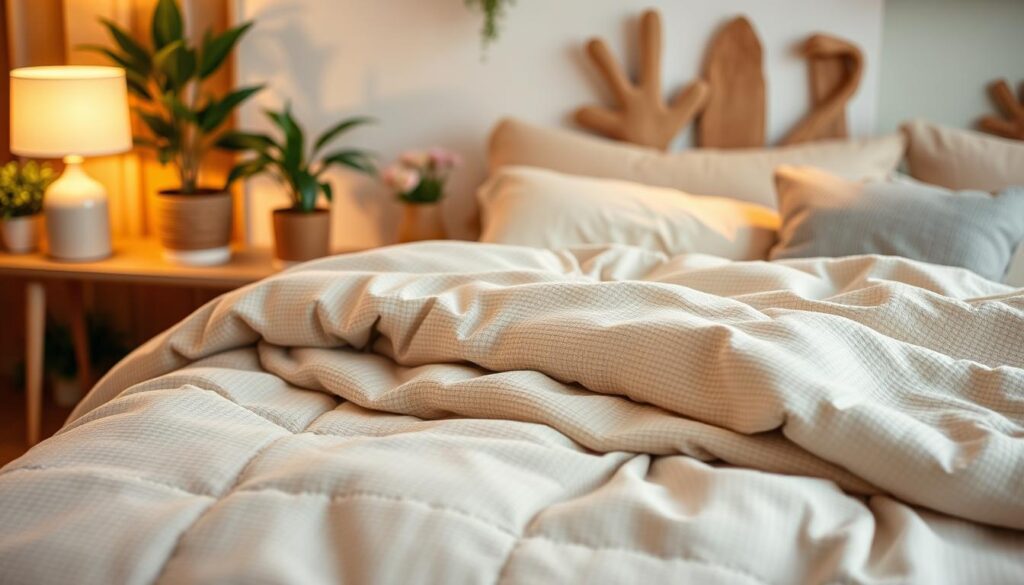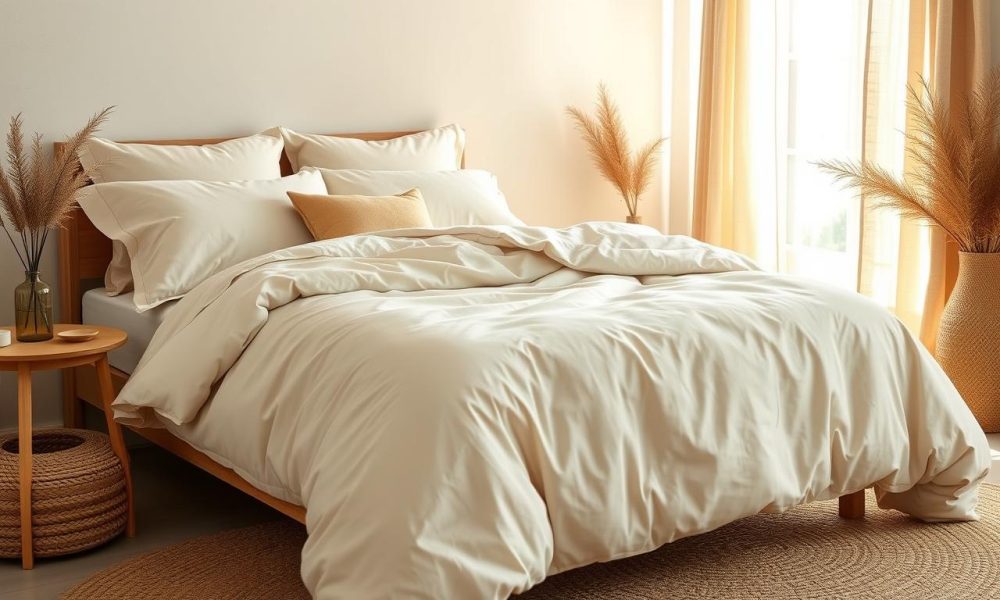Choosing eco-friendly bedding is a big step towards a sustainable lifestyle. It improves your sleep quality and helps the planet. It’s a simple change that makes a big difference.
Traditional bedding can harm the environment. But, sustainable bedding is made with the earth in mind. It uses materials that are kind to our planet and make your bedroom greener.
By picking eco-friendly bedding, you support green practices. You also make your sleep space healthier for you.
Key Takeaways
- Choose sustainable bedding to reduce your environmental footprint.
- Eco-friendly bedding promotes a healthier sleep environment.
- Sustainable materials are gentle on the earth.
- Upgrade your bedroom with green bedroom solutions.
- Support environmentally responsible practices.
What is Eco-Friendly Bedding?
Eco-friendly bedding aims to reduce harm to the environment. Eco-friendly bedding uses materials that are kind to our planet.
Understanding eco-friendly bedding is key. Eco-friendly bedding is more than a trend. It’s a choice for a better sleep and a greener future.
Definition and Importance
Eco-friendly bedding comes from sustainable sources. It’s made with care for our planet. Choosing it helps lower pollution and saves resources.
Learn more about sustainable bedding at The Ultimate Guide to Sustainable Bedding. It offers tips for eco-friendly choices.
Materials Used in Eco-Friendly Bedding
Materials in eco-friendly bedding are key to its greenness. Organic cotton, bamboo, and Tencel are top picks. They’re chosen for their eco-friendliness, durability, and softness.
Organic cotton is grown without harmful chemicals. Bamboo is fast-growing and uses little water. Tencel is made from wood pulp and is breathable. Choosing these materials improves your sleep and supports green manufacturing.
Benefits of Switching to Eco-Friendly Bedding
Choosing eco-friendly bedding means a healthier sleep space and supporting the planet. This simple change can greatly improve your health and the environment.

Health Benefits for You
Eco-friendly bedding cuts down on harmful chemicals, making your sleep better. Traditional bedding can release chemicals that irritate your skin and lungs. On the other hand, sustainable bedding uses natural materials that are kind to your skin and lower allergy risks.
“Natural and organic bedding reduces chemical exposure,” a sleep expert notes. “This can improve your sleep and health.”
Also, eco-friendly bedding helps keep your body temperature right, which is good for sleep. Materials like organic cotton and Tencel keep you cool in summer and warm in winter.
Positive Environmental Impact
Making environmentally friendly linens supports green farming and making. Organic cotton, for example, means no toxic pesticides or synthetic fertilizers. This helps the soil, saves water, and lessens farming’s environmental harm.
Also, brands that focus on eco-friendly bedding use less packaging and shipping. Your choice of sustainable bedding tells makers to care more about the planet.
In short, switching to eco-friendly bedding boosts your health and helps the planet. It’s a win-win choice with many health benefits and positive effects on the environment.
Popular Eco-Friendly Bedding Materials
Choosing the right eco-friendly bedding starts with knowing the materials that make it sustainable. You have several options when it comes to bedding made from natural and sustainable sources.
Organic Cotton
Organic cotton is a top choice for eco-friendly bedding. It’s grown without toxic pesticides or synthetic fertilizers. This makes organic cotton better for the environment and healthier for you.
Organic sheets are soft, breathable, and durable. They’re a great choice for upgrading your bedding.
Tencel and Lyocell
Tencel and Lyocell are sustainable forms of lyocell fiber. They’re made from wood pulp, often from eucalyptus or birch trees. These natural fiber bedding options are known for their moisture-wicking properties and breathability.
They also feel gentle against the skin.
Bamboo
Bamboo bedding is popular for its softness and eco-friendly qualities. Bamboo grows quickly, needing little water and no pesticides. Bedding made from bamboo is hypoallergenic and breathable.
When choosing eco-friendly bedding, think about what matters to you. Whether it’s organic cotton, the sustainability of Tencel and Lyocell, or the luxurious feel of bamboo, you’re helping the environment.
How Eco-Friendly Bedding is Made
Making eco-friendly bedding combines sustainable materials and careful manufacturing. This method cuts down on environmental harm. It also makes sure the bedding is safe and healthy for users.
Sustainable Manufacturing Processes
Manufacturers of eco-friendly bedding use sustainable manufacturing processes. These methods cut down on waste and energy use. They often run on renewable energy like solar or wind power.
Many also use closed-loop systems. These systems recycle water and materials, lowering environmental impact.

Choosing the right materials is key. Eco-conscious textiles like biodegradable or recyclable ones are used. This choice greatly reduces the product’s environmental footprint.
Fair Trade Practices
Fair trade is a big part of making eco-friendly bedding. It means workers get fair pay and safe working conditions. Fair trade also helps workers improve their lives.
Supporting fair trade helps create a better supply chain. It benefits workers and makes the bedding better and more trustworthy.
Choosing eco-friendly bedding supports a fair and sustainable world. It’s not just about better sleep. It’s about making a positive change.
Tips for Choosing Eco-Friendly Bedding
Choosing the right eco-friendly bedding can seem hard. But, focusing on certifications and your sleep needs makes it easier.
Look for Certifications
When you’re looking for eco-friendly bedding, check for certifications. These show the product meets environmental and health standards. Look for GOTS (Global Organic Textile Standard) and Oeko-Tex certifications. They mean the bedding is organic and free from harmful chemicals.
| Certification | Description | Benefits |
|---|---|---|
| GOTS | Ensures textiles are made from organic fibers | Environmentally friendly, safe for sensitive skin |
| Oeko-Tex | Certifies textiles are free from harmful substances | Reduces exposure to chemicals, safe for all ages |
Consider Your Sleep Needs
Your sleep needs are key when choosing bedding. Think about whether you like soft, breathable fabrics or something firmer. Eco-friendly bedding comes in many materials, like organic cotton, Tencel, and bamboo. Each offers a different comfort level.
Consider your sleeping habits too. Do you sleep hot or cold? Some eco-friendly materials are better at keeping you cool or warm. For example, bamboo bedding is great for keeping you cool because it’s breathable.
Caring for Eco-Friendly Bedding
Looking after your chemical-free bed linens is key to keeping them in top shape. By following the right washing and care tips, your eco-friendly bedding will stay comfy and last longer.
Washing and Maintenance Tips
Wash your eco-friendly bedding in cold water to keep it in great condition. Cold water is better for the fabric and saves energy. Also, use a mild detergent without harsh chemicals to keep it eco-friendly. For more tips, check out The Ultimate Guide to Sustainable Bedding.
Don’t over-dry your bedding. Take it out of the dryer when it’s a bit damp and let it air dry. This helps avoid wrinkles and wear. Washing it regularly is good, but too much can damage the fabric.
Avoiding Harmful Chemicals
When washing your bedding, stay away from harsh chemicals and bleach. These can harm the fabric and undo the eco-friendly benefits. Choose eco-friendly detergents that are safe for the planet.
By following these care tips, you can enjoy your eco-friendly bedding for years. It’s a step towards a greener lifestyle.
Where to Buy Eco-Friendly Bedding
Finding the right bedding for a greener bedroom is key. We’re here to help you find it. Many brands now offer eco-friendly bedding options due to growing demand.
Reputable Brands to Consider
Look for reputable brands that focus on sustainability when searching for eco-friendly bedding. Brands like those with eco-friendly bedding collections are known for using organic materials and sustainable methods.
| Brand | Notable Features | Certifications |
|---|---|---|
| Takasa | Eco-friendly bedding made from organic cotton | GOTS, Oeko-Tex |
| Boll & Branch | Sustainable bedding with eco-friendly materials | GOTS, Fair Trade |
| Parachute | Turkish cotton bedding with a focus on sustainability | Oeko-Tex, Fair Trade |
Online vs. Local Shopping
You can buy eco-friendly bedding online or in local stores. Online shopping is convenient and offers a wide selection. You can read reviews and compare prices easily. Local stores let you touch and feel the products before buying.
Think about what matters most to you. Online shopping is great for convenience and variety. Local stores are better for seeing and feeling the quality of bedding before you buy.
Choosing between online and local shopping depends on your preferences and needs. Buying eco-friendly bedding from reputable brands improves your sleep and helps the planet.
Eco-Friendly Bedding and Allergies
Switching to eco-friendly bedding can greatly improve your allergy symptoms. It’s made from materials that are good for your skin and the planet. If you wake up with itchy eyes and a runny nose, it’s time to try eco-friendly bedding.
Benefits for Allergy Sufferers
Eco-friendly bedding is made from natural materials that are hypoallergenic. This means they’re less likely to cause allergic reactions. Unlike regular bedding, which may have harsh chemicals, these options are kind to your skin and the environment.
Choosing bedding from organic cotton, bamboo, or Tencel can lower your exposure to allergens.
Key benefits for allergy sufferers include:
| Benefit | Description |
|---|---|
| Reduced exposure to harsh chemicals | Eco-friendly bedding avoids chemicals that can irritate skin and trigger allergies. |
| Hypoallergenic materials | Natural materials in eco-friendly bedding are less likely to cause allergic reactions. |
| Improved sleep quality | Eco-friendly bedding can lead to better sleep by reducing allergy symptoms. |
Hypoallergenic Options
When looking for hypoallergenic bedding, search for organic cotton, bamboo, or Tencel. These materials are soft on your skin and breathable. They also help keep you cool and dry while you sleep.

Some popular hypoallergenic bedding options include:
- Organic cotton bedding, grown without harmful pesticides or synthetic fertilizers.
- Bamboo bedding, known for its breathability and natural resistance to dust mites.
- Tencel bedding, made from wood pulp and excellent at wicking away moisture.
Choosing eco-friendly, hypoallergenic bedding creates a healthier sleep space. It’s good for your health and supports sustainable practices.
Eco-Friendly Bedding for Kids
Eco-friendly bedding for kids is more than a trend; it’s essential for their health and the planet’s. As a parent, you aim to give your kids the best start, including a healthy sleep space.
Choosing the right bedding means thinking about your kids’ health, comfort, and safety, and the planet’s well-being. Sustainable bedding options are soft, breathable, and long-lasting. They ensure your kids sleep comfortably.
Safe and Sustainable Choices
When picking eco-friendly bedding, look for materials without harmful chemicals. Organic cotton and bamboo are great because they’re soft, breathable, and safe for kids’ skin.
Here’s a look at popular eco-friendly materials for kids’ bedding:
| Material | Breathability | Softness | Environmental Impact |
|---|---|---|---|
| Organic Cotton | High | Very Soft | Low Impact |
| Bamboo | Very High | Soft | Low Impact |
| Tencel | High | Very Soft | Low Impact |
Brands Specializing in Children’s Bedding
Many brands focus on eco-friendly bedding for kids, providing stylish and sustainable choices. Some top brands include:
Boll & Branch and Parachute are known for their high-quality, eco-friendly bedding made from sustainable materials.
When looking for eco-friendly bedding, choose brands that value sustainability and transparency. By picking eco-friendly bedding, you ensure a healthier sleep space for your kids. You also support sustainable practices that help the planet.
Eco-Friendly Bedding and Sleep Quality
Choosing the right eco-friendly bedding can greatly improve your sleep. The materials in your bedding are key to a good night’s sleep. Sustainable bedding helps create a healthier sleep space, which is vital for your well-being.
Improving Sleep with Sustainable Materials
Eco-friendly bedding is made from materials that are good for the planet and your skin. Organic cotton, Tencel, and bamboo are favorites because they are breathable, soft, and hypoallergenic. These materials keep your body temperature right and reduce allergens, making for better sleep.
Using sustainable materials means fewer chemicals and dyes, making a healthier sleep space. This is great for those with allergies or sensitivities. By picking eco-friendly bedding, you’re not just improving your sleep but also helping the planet.
Eco-Friendly Options for All Sleep Styles
Whether you sleep hot or cold, or prefer soft or firm bedding, there’s something for you. For example, bamboo bedding keeps you cool in summer and warm in winter. On the other hand, organic cotton is perfect for those who love soft, breathable fabrics.
Think about the thread count and weave of your bedding too. A higher thread count often means softer fabric, but make sure it’s eco-friendly. Some brands offer high-thread-count organic cotton bedding that’s both luxurious and sustainable.
By picking the right eco-friendly bedding for your sleep style, you can greatly improve your sleep. It’s about making a sleep space that’s healthy and sustainable.
Transforming Your Bedroom with Eco-Friendly Decor
Now that you’ve switched to eco-friendly bedding, it’s time to upgrade your bedroom. Add green decor and sustainable accessories to make it a relaxing space. This way, you’ll enjoy a peaceful night’s sleep.
Creating a Cohesive Look
To make your bedroom eco-friendly, mix your new bedding with sustainable furniture and decor. Look for items made from reclaimed wood, bamboo, or other eco-friendly materials. This will make your bedroom look great and support the environment.
Accessorizing Sustainably
For accessorizing, choose items that are stylish and green. Pick lamps, vases, and other decor made from natural materials or recycled glass. This adds a green touch to your bedroom and reduces your environmental impact.
By adding these elements, you’ll have a bedroom that’s both beautiful and eco-friendly. Enjoy your new green haven!























